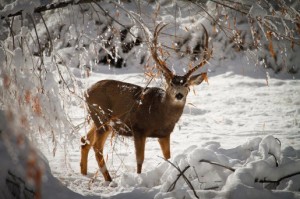Wildlife biologists have been monitoring big game animals across Utah, collecting data and analyzing it from the thousands of hunters who hunted big game last autumn.
 After surveying the herds from the ground and the air, and analyzing data collected from hunters — data that provides important information about how big game animals are doing in Utah — biologists are ready to share their big game hunting permit recommendations for this fall’s hunts.
After surveying the herds from the ground and the air, and analyzing data collected from hunters — data that provides important information about how big game animals are doing in Utah — biologists are ready to share their big game hunting permit recommendations for this fall’s hunts.
You can see the biologists’ recommendations at www.wildlife.utah.gov/dwr/hunting/board-rac.html.
After reviewing the recommendations, plan on sharing your ideas at your upcoming Regional Advisory Council meeting. RAC chairs will take the input they receive and share it with members of the Utah Wildlife Board when the board meets in Salt Lake City on May 2 to approve permits for this fall’s big game hunts.
RAC meetings are scheduled for the following dates and times:
Southern Region, April 9, 5 p.m. Beaver High School 195 E. Center St., Beaver
Southeastern Region, April 10, 6:30 p.m., John Wesley Powell Museum 1765 E. Main St., Green River
Northeastern Region, April 11, 5 p.m., DWR Northeastern Region Office 318 N. Vernal Ave., Vernal
Central Region, April 16, 6:30 p.m., Springville Public Library Meeting Room 45 S. Main St., Springville
Northern Region, April 18, 6 p.m., Brigham City Community Center 24 N. 300 W., Brigham City
Also provide comments to your RAC via email. Email addresses for your RAC members are available at www.wildlife.utah.gov/dwr/rac-members.html.
The group each RAC member represents (sportsman, non-consumptive, etc.) is listed under each person’s email address. You should direct your email to the people on the RAC who represent your interest.
Deer, elk, pronghorn permits
The following are among the biologists’ recommendations:
* Decrease the number of general buck deer hunting permits from 86,500 in 2012 to 84,600 for this autumn’s hunts.
Division of Wildlife Resources Big Game Coordinator Anis Aoude says two factors determine how many buck deer permits can be offered on a unit in the fall: The average number of bucks per 100 does on the unit over the past three years and whether that number has increased, decreased or stayed the same during the three-year period.
Biologists found a little of everything on Utah’s 30 general-season units after the deer hunt was over last fall. On some units, the number of bucks per 100 does was above objective for the unit and was growing. Other units were stable. And, on some units, the number of bucks per 100 does was declining.
“Based on the data we collected,” Aoude says, “we’re recommending 1,900 fewer permits for this fall’s hunts.”
Aoude says the number of bucks killed by hunters last fall was up about 34 percent from 2011. The total number of deer in Utah, after the hunts were over, was up too.
“Two years ago, after the hunts in 2011,” he says, “the statewide deer population was about 286,000 deer. Despite hunters taking more bucks in 2012, about 318,000 deer were still in the state after the hunts were over last fall. That’s encouraging. It shows the overall deer population is growing.”
* Decrease the number of limited-entry buck deer permits from 967 in 2012 to 860 for this fall’s hunts.
Protecting bucks on the north end of the Book Cliffs is the major reason for the recommended decrease.
Aoude says most of the bucks killed on the Book Cliffs are taken on the north end of the unit. The time of year when the hunt is held, and fairly open terrain that makes it easier for hunters to see deer, has led to more deer being taken on the north end of the unit than on the south end.
“The low number of fawns that are produced on the Book Cliffs makes it harder to replace bucks once they’re taken,” Aoude says.
* Increase cow elk permits from 14,763 in 2012 to 17,982.
Aoude says Utah’s elk populations are doing well. So well, in fact, that more cow elk permits are needed to try to bring the total number of elk back to the statewide management objective of 70,965 animals.
* Increase buck pronghorn permits from 664 in 2012 to 753 for this fall’s hunts. Also, increase doe pronghorn permits from 537 in 2012 to 962 for this fall.
The productive pronghorn herd on the Parker Mountains in southwestern Utah is the major reason for the increase. A tough winter hit the unit two years ago, killing a lot of pronghorns and dropping the herd below its management objective.
“This is a really productive herd, though,” Aoude says. “The animals have already bounced back. We need to offer more doe pronghorn permits to get the animals back to the management objective of 1,500 pronghorn.”
For more information about the upcoming meetings, call the nearest Division of Wildlife Resources office or the DWR’s Salt Lake City office at 801-538-4700.
Source: Utah Division of Wildlife Resources
